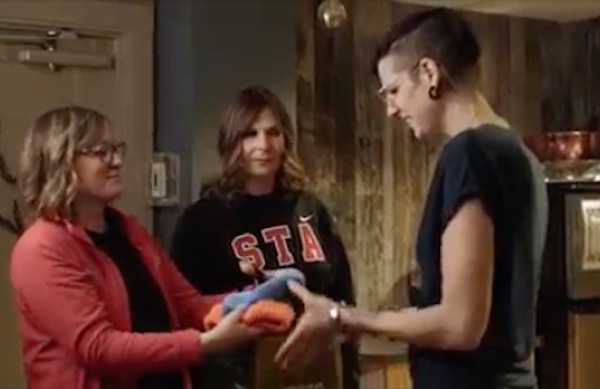Community
Red Deer Catholic Regional School Division mobilizes to raise funds for vulnerable women

CSS Morning Star program lifts women in lasting ways
News Release from Catholic Social Services
Teachers across Red Deer Catholic Regional School Division are raising funds to support the vulnerable women served by Catholic Social Services’ Morning Star program.
“It’s just something that is very important to us, that we teach our children about helping less fortunate and being a part of a community and a faith filled community.” Melissa Meyer, teacher at St. Thomas Aquinas School.
Last winter, a class at St. Thomas Aquinas school in Red Deer organized a drive to collect over 100 clothing accessories for Morning Star. This year, the entire school division is participating. Fundraising kicked off on May 9, and will continue through to the end of the school year.
Red Deer Catholic Regional School Division has held a lunch day where faculty and pupils were able to order lunch from local restaurants, Millennium Cafe and Bo’s Bar & Stage, where a portion of proceeds will be donated to Morning Star. This week (May 9-13), faculty are participating by donating $20 to dress down for theme days. Themes include Gear down for a good cause, Jeans for justice, Sweathog Day, Just Cause Jeans, and High School Throwback, where teachers and staff may dress in jeans and sportswear at school. Another planned initiative includes a 50/50 draw on May 20.
“The support means a lot and there’s something that really touches our hearts about the youth as well wanting to get involved in their community and help build up their community even from a young age. It means a lot to us.” Jill Lanz, Service Coordinator at Morning Star.
Morning Star opened in downtown Red Deer in 2019, following a viability analysis which identified significant gaps in the community for women experiencing homelessness, addiction, and other self-identified barriers. Morning Star is the only program exclusively serving women, an important feature for those who may have experienced abuse and/or human trafficking.
The program aims to lift women in lasting ways through both outreach and drop-in services. The Morning Star drop-in centre offers a safe place for women to access showers and laundry services, snacks, clothing, toiletries, and the friendship and support of staff. Morning Star served 168 women last year, and currently receives 140-260 visits monthly.
“Part of our jobs is we will carry hope for our women until they can carry it for themselves,” Lanz describes her role at Morning Star.
Morning Star is entirely funded through donations to Sign of Hope, Catholic Social Services’ charitable fundraising arm. The program costs $250,000 annually to operate. Those interested can make donations at (LINK)
Local Filmmaker Involvement
A video by a local Red Deer filmmaker Corey Gomez was produced to support the Red Deer Catholic Regional School Division fundraising efforts. Gomez has been involved with projects including Billy the Kid, ATCO, Government of Alberta, and a television show produced by Ron Howard.
About CSS:
For 60 years, Catholic Social Services has been providing help to the most vulnerable. Today, CSS works in three priority areas: serving newcomers to Canada, serving individuals with disabilities, and serving individuals, children, and families. Each year, more than 21,000 Albertans in 12 communities across central Alberta, are uplifted and empowered through CSS.
Community
SPARC Red Deer – Caring Adult Nominations open now!

Red Deer community let’s give a round of applause to the incredible adults shaping the future of our kids. Whether they’re a coach, neighbour, teacher, mentor, instructor, or someone special, we want to know about them!
Tell us the inspiring story of how your nominee is helping kids grow up great. We will honour the first 100 local nominees for their outstanding contributions to youth development. It’s time to highlight those who consistently go above and beyond!
To nominate, visit Events (sparcreddeer.ca)

Addictions
‘Harm Reduction’ is killing B.C.’s addicts. There’s got to be a better way

From the Frontier Centre for Public Policy
B.C. recently decriminalized the possession of small amounts of illicit drugs. The resulting explosion of addicts using drugs in public spaces, including parks and playgrounds, recently led the province’s NDP government to attempt to backtrack on this policy
Fuelled by the deadly manufactured opioid fentanyl, Canada’s national drug overdose rate stood at 19.3 people per 100,000 in 2022, a shockingly high number when compared to the European Union’s rate of just 1.8. But national statistics hide considerable geographic variation. British Columbia and Alberta together account for only a quarter of Canada’s population yet nearly half of all opioid deaths. B.C.’s 2022 death rate of 45.2/100,000 is more than double the national average, with Alberta close behind at 33.3/100,00.
In response to the drug crisis, Canada’s two western-most provinces have taken markedly divergent approaches, and in doing so have created a natural experiment with national implications.
B.C. has emphasized harm reduction, which seeks to eliminate the damaging effects of illicit drugs without actually removing them from the equation. The strategy focuses on creating access to clean drugs and includes such measures as “safe” injection sites, needle exchange programs, crack-pipe giveaways and even drug-dispensing vending machines. The approach goes so far as to distribute drugs like heroin and cocaine free of charge in the hope addicts will no longer be tempted by potentially tainted street drugs and may eventually seek help.
But safe-supply policies create many unexpected consequences. A National Post investigation found, for example, that government-supplied hydromorphone pills handed out to addicts in Vancouver are often re-sold on the street to other addicts. The sellers then use the money to purchase a street drug that provides a better high — namely, fentanyl.
Doubling down on safe supply, B.C. recently decriminalized the possession of small amounts of illicit drugs. The resulting explosion of addicts using drugs in public spaces, including parks and playgrounds, recently led the province’s NDP government to attempt to backtrack on this policy — though for now that effort has been stymied by the courts.
According to Vancouver city councillor Brian Montague, “The stats tell us that harm reduction isn’t working.” In an interview, he calls decriminalization “a disaster” and proposes a policy shift that recognizes the connection between mental illness and addiction. The province, he says, needs “massive numbers of beds in treatment facilities that deal with both addictions and long-term mental health problems (plus) access to free counselling and housing.”
In fact, Montague’s wish is coming true — one province east, in Alberta. Since the United Conservative Party was elected in 2019, Alberta has been transforming its drug addiction policy away from harm reduction and towards publicly-funded treatment and recovery efforts.
Instead of offering safe-injection sites and free drugs, Alberta is building a network of 10 therapeutic communities across the province where patients can stay for up to a year, receiving therapy and medical treatment and developing skills that will enable them to build a life outside the drug culture. All for free. The province’s first two new recovery centres opened last year in Lethbridge and Red Deer. There are currently over 29,000 addiction treatment spaces in the province.
This treatment-based strategy is in large part the work of Marshall Smith, current chief of staff to Alberta’s premier and a former addict himself, whose life story is a testament to the importance of treatment and recovery.
The sharply contrasting policies of B.C. and Alberta allow a comparison of what works and what doesn’t. A first, tentative report card on this natural experiment was produced last year in a study from Stanford University’s network on addiction policy (SNAP). Noting “a lack of policy innovation in B.C.,” where harm reduction has become the dominant policy approach, the report argues that in fact “Alberta is currently experiencing a reduction in key addiction-related harms.” But it concludes that “Canada overall, and B.C. in particular, is not yet showing the progress that the public and those impacted by drug addiction deserve.”
The report is admittedly an early analysis of these two contrasting approaches. Most of Alberta’s recovery homes are still under construction, and B.C.’s decriminalization policy is only a year old. And since the report was published, opioid death rates have inched higher in both provinces.
Still, the early returns do seem to favour Alberta’s approach. That should be regarded as good news. Society certainly has an obligation to try to help drug users. But that duty must involve more than offering addicts free drugs. Addicted people need treatment so they can kick their potentially deadly habit and go on to live healthy, meaningful lives. Dignity comes from a life of purpose and self-control, not a government-funded fix.
Susan Martinuk is a senior fellow at the Frontier Centre for Public Policy and author of the 2021 book Patients at Risk: Exposing Canada’s Health Care Crisis. A longer version of this article recently appeared at C2CJournal.ca.
-

 COVID-1917 hours ago
COVID-1917 hours agoCDC Quietly Admits to Covid Policy Failures
-

 Brownstone Institute7 hours ago
Brownstone Institute7 hours agoDeborah Birx Gets Her Close-Up
-

 COVID-1920 hours ago
COVID-1920 hours agoJapanese study shows disturbing increase in cancer related deaths during the Covid pandemic
-

 Great Reset15 hours ago
Great Reset15 hours agoClimate expert warns against extreme ‘weather porn’ from alarmists pushing ‘draconian’ policies
-

 espionage10 mins ago
espionage10 mins agoConservative MP testifies that foreign agents could effectively elect Canada’s prime minister, premiers
-

 Economy2 days ago
Economy2 days agoExtreme Weather and Climate Change
-

 Bruce Dowbiggin2 days ago
Bruce Dowbiggin2 days agoWhy Are Canadian Mayors So Far Left And Out Of Touch?
-

 International2 days ago
International2 days agoTelegram founder tells Tucker Carlson that US intel agents tried to spy on user messages


